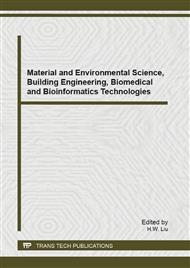[1]
X. B Fu, Z. G Wu et al. The modern theory and practice of wound dressing. M. Chemical industry press.
Google Scholar
[2]
G. Winter. Nature 193: 293-294(1962).
Google Scholar
[3]
Z. G Wang. Shandong science and technology press. 231-233(2000).
Google Scholar
[4]
W. B Gao, Y. R Zhang, J. Zhang. Chinese Journal of Tissue Engineering Research, 29(2012), p: 16.
Google Scholar
[5]
D. E Vriezes, P. Westbroek, C. T Van, et al. Journal of Materials Science, 8029-8034(2007).
Google Scholar
[6]
J. A Matthews, G. E Wnek, D. G Simpson, et al. Biomacromolecules, 232-238(2002).
Google Scholar
[7]
B. M Min, Leeg, S. H Kim, et al. Biomaterials, 1289-1297.
Google Scholar
[8]
S. B Mitchell, J. E Sanders. Journal of Biomedical Materials Research. Part A, 110-120(2006).
Google Scholar
[9]
A. Koski, K. Yim, S. Shivkumar. Materials Letters, 493-497(2004).
Google Scholar
[10]
I. G Loscertales, A. Barrero, I. Guerrero. Science, 1 695-1 698(2002).
Google Scholar
[11]
Z. Sun, E. Zussman, A. I Yafin. Advanced Materials, 1929-1932(2003).
Google Scholar
[12]
E. A Vargas, N. C do-Vale-Baracho, J. de-Brito, et al. Acta Biomater, 1069-1078(2010).
Google Scholar
[13]
R. Jayakumar, M. Prabaharan P.T. K. Sudheesh et al. Biotechnology Advances, 322–337(2011).
Google Scholar
[14]
J. Zeng, X. Y Xu, X. S Chen, et al. Journal of Controlled Release, 227-231(2003).
Google Scholar
[15]
X. Liu, T. Lin, J. Fang, G. Yao, H. Zhao, M. J. Journal of Biomedical Materials Research part A, 9999A.
Google Scholar
[16]
J. Miao, R. C Pangule, E. E Paskaleva, E. E Hwang, R. S Kane, R. J Linhardt, J. S Dordick Biomaterials , 9557(2011).
DOI: 10.1016/j.biomaterials.2011.08.080
Google Scholar
[17]
R. Chen, H. Chen, Qinfei Ke et al. Colloids and Surfaces B: Biointerfaces, 315-325(2010).
Google Scholar
[18]
polyurethane/collagen compound nanofibers for tissue engineering applications. J. Colloids and Surfaces B: Biointerfaces, 315-325(2010).
DOI: 10.1016/j.colsurfb.2010.03.043
Google Scholar
[19]
B. Ding, Y. U Jianyong et al. Electrospinning and nanofibers. M.
Google Scholar


